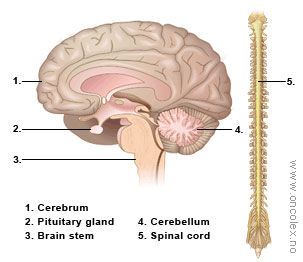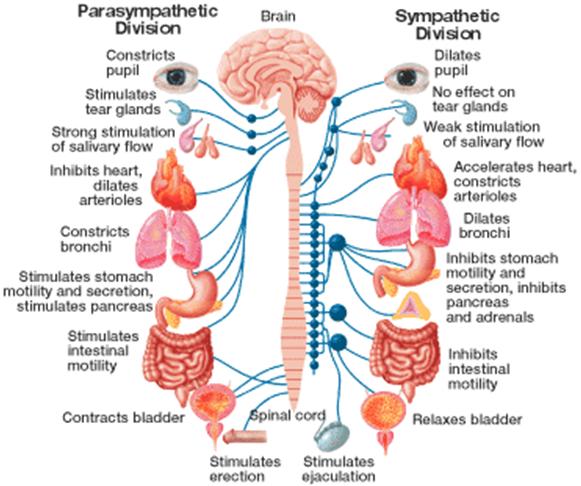Lesson 3: Basic Neuropsychology and Genetic Issues
Attention
Take a look at this video regarding the basic structures and functions of the brain.
Click HERE to view this directly on YouTube
Learning Outcomes
Upon completion of this lesson's material, students will
- Have a basic understanding of the body's nervous system
- Understand how neurotransmitters work and the connection to mental function
- Understand and be able to state how physiological factors affect mental disorders including SUDS
Reading
Teaching
THE CENTRAL NERVOUS SYSTEM
All behavior is grounded in the Central Nervous System (Brain/Spine)

This does not mean that we are maintaining materialism or determinism as explanatory of substance disorders but rather that explanation begins with the CNS
The CNS operates through neurons: cells that send messages through chemical mediators (neurotransmitters) that are related to electrical activity in the neuron

The neuron depicted above is typical: all you need to know is that at each end, there are structures capable of emitting and absorbing chemicals that communicate with adjacent neurons, and that between the two ends, an electrical impulse is transmitted through the Schwann cells so that the chemical message received at one end is passed on to the other end electrically. It is this electrical activity that is picked up in electroencephelograms.
Mental disorders including substance disorders seem to be causally related to excesses or deficiencies of these chemical mediators that communicate between neurons.
The CNS is composed of the Brain and Spine and the Spine is how information gets to and from the brain while the brain is where information is processed (sensations, perceptions, thoughts and feelings) and acted upon (behavioral initiation and execution in terms of reflexes and operants as well as homeostatic regulation of organs)
Part of the CNS largely located in the Spine ( but also involving the mid brain and hind brain) is the Autonomic (self-regulating, self-ruling) Nervous System which regulates our bodily systems largely without conscious involvement
Here is a picture representing how the Autonomic Nervous System is responsible for specific functions.
The Autonomic Nervous System (ANS), pictured above, is subcortical and involves the brain stem and spine, areas 3 and 5 of the Central Nervous System.
The ANS as you can see is separated into Sympathetic (in the sense of being coordinated with arousal and our feelings---anger, fear, fight or flight) and Parasympathetic (in the sense of acting in a different direction than the Sympathetic being associated largely with resting and relaxing)
The ANS is also involved in SUDS with stimulants largely affecting the Sympathetic (through epinephrine---adrenaline--- with its associated sense of excitement) and sedatives largely affecting the Parasympathetic (through aceylcholine which in this case produces relaxation) and in each case being a valued part of the "high"
Although the ANS is "involuntary", our thoughts can affect it. By imagining ourselves on a roller coaster, for example, we can produce epinephrine and raise heart rate and blood pressure. By imagining an erotic image we can produce genital sensations and even orgasm
NEUROTRANSMITTERS
Neurons sensitive to these mediators are found throughout both Central and Peripheral Nervous Systems and the transmitters may act in significant ways at any point so that there may be very complex interactions that finally explain the observed behavior.
- Dopamine is involved in many parts of the CNS (for example in motor behavior) but seems to be especially important in the limbic system in terms of perceived pleasure. Dopamine is also thought to be involved in the pathogenesis of schizophrenia.
- Remember this if nothing else about dopamine: it is the final common pathway for all addictive substances. Substances may cause the release of other neurotransmitters (e.g. nicotine-acetylcholine, opiates-endorphins, cocaine-epinephrine) but they are addictive because finally they produce dopamine in the pleasure center of the brain---the basal ganglia in the limbic system.
- Endorphins are associated with the endogenous opiate system and are involved in analgesia and feelings of well-being and ultimately opiates cause a release of dopamine in the limbic system which makes them addictive. Involved in addiction to both alcohol and opiates.
- Epinephrine is involved in the activity of the sympathetic nervous system that keeps us breathing and our heart going but may also give us a sense of energy and alertness. Epinephrine seems to be associated with anxiety disorders. Cocaine and amphetamines and caffeine cause release of epinephrine (giving a sense of energy and alertness). They also affect dopamine in the limbic system so that more dopamine remains present. Remember that it is this dopamine effect that makes these substances addictive. Medications for ADHD such as Ritalin produce an increase of dopamine and epinephrine in the prefrontal cortex improving concentration, attention and impulse control which leads scientists to believe that a deficiency in these transmitters in this parts of the brain is part of the cause for the disorder. Even though these medications produce dopamine, they are not usually addictive in children or adults if the ADHD diagnosis is correct because they are simply correcting a dopamine deficiency. If these meds are used by people who do not have ADHD, they are mildly addictive.
- Acetylcholine is involved in the activity of the parasympathetic nervous system and acts in balance with the sympathetic system to help us relax and let go (e.g., ejaculation, defecation, digestion). Nicotine affects acetylcholine receptors producing a sense of relaxation; it also affects epinephrine receptors producing a sense of energy and alertness and finally causes the release of dopamine in the limbic system producing a sense of pleasure and leading to addiction.
- Serotonin is a neurohumoral mediator that has been thought to be involved in depression and may be involved in use of Ecstacy. Serotonin may mediate a sense of well-being associated with feeling satisfied.
The GABA/Glutamate System
- Alcohol, benzodiazepines and barbiturates affect a broader system of receptors in the GABA/Glutamate system which works in our circadian rhythm to wake us up and put us to sleep. The effect on the GABA/Glutamate system is to enhance the presence of GABA causing sedation. (Alcohol also affects endorphin receptors giving the person a sense of well-being.) These substances also result in dopamine release in the limbic system making them addictive.
- The GABA system is associated with relaxation while the Glutamate system is associated with arousal. Their interaction is complex and any impairment can be devastating. It is the association of alcohol, benzodiazepines and barbiturates with these systems that causes the life threatening withdrawal symptoms that makes this group of substances so dangerous.
Cannabis Receptors
- Cannabis affects a receptor system that is yet poorly understood but that is involved in analgesia, relaxation and enhancement of perception. Again there is a release of dopamine in the limbic system which makes cannabis addictive.
- There are two kinds of Cannabis Receptors but most of the connection to SUDS is through the first kind (CB 1). Also there are two main active ingredients in cannabis, tetrahydrocannabinol (which causes the high and affects CB1 receptors) and cannabidiol which is more related to analgesia (and primarily affects CB2 receptors).
OTHER CNS FACTORS
There are many other CNS factors and dynamics that affect substance use so that we should not think that understanding this neurochemistry has completely explained substance dependence.
This understanding is valuable towards beginning to think about how to help. For example, if there is a specific nicotine receptor in the CNS, then perhaps a medication that affects this receptor will help people to stop smoking. This is the idea behind Chantix which is a medication that blocks the nicotine receptor making people think they have already had a cigarette and keeping them from craving another. Another example is Naltrexone which blocks opiate receptors and can be helpful in the treatment of both opiate and alcohol addiction because it somewhat reduces craving.
Finally, we need to understand that although nothing happens without the CNS, understanding whats going on in the CNS is not an exhaustive explanation of the behaviors with which we are concerned. For example, knowing that a genetic deficiency in dopamine receptors in the limbic system explains why some people become addicted practically from their first use of substances does not explain the whole phenomenon of addiction even in a single instance. In each case there are always other psychological, social and even spiritual factors involved which help us to understand the case under consideration in a practical and helpful way.
Assessment
In this section you will find a list of the required Assessments that accompany this Lesson. The Lesson Discussions are designed for the ONLINE and HYBRID versions of this course. If you are not in an ONLINE or HYBRID version of this course you can ignore these instructions unless otherwise guided by your instructor.
Lesson 3 Quiz
- Why is it important to understand the role of the central nervous system when learning about substance use disorders and treatments?
- Differentiate between the sympathetic and the parasympathetic nervous systems. Which one do you think stimulants such as cocaine and methamphetamine target?
Lesson 3 Discussion A (for online students only)
Write a paragraph describing what you think about the relationship of the brain to addiction. Write another paragraph stating what factors influence addiction in addition to the brain and which factors in your experience have been most important in cases of addiction that you have seen.
Lesson 3 Discussion B (for online students only)
In this discussion, I would like you to post your Introductory Video. For this task you are going to create a brief introductory video of yourself using your iPad! Reply to each others' posts with questions and comments. See the instructions below in the iPad Integration box.
Each iPad comes preloaded with a camera that can take photos and videos with. There is also a photo app where all the videos and photos you take are stored. Please use your video camera and make a brief video of yourself. The easiest way to share a video is to then upload the video to YouTube and share the link with your classmates.
Camera
iPhoto
YouTube To upload a video to YouTube, you need to have a gmail account. If you have not set one up then go online and set up a gmail email and password. It will be important to save this informaiton for future reference. Once you have a gmail account you can then set up your YouTube account. Once your YouTube account is set up and the app is loaded on your iPad you should be able to open a video, click on the share button (box with up arrow) and select share with YouTube. This then sends a copy of your video to YouTube. Once the video is loaded in YouTube you can then open your video and select the share option that says share the link. You will post the link in the discussion board for your classmates and instructor to view. Please let your Instructor know if you need additional support in learning how to do this process. |




